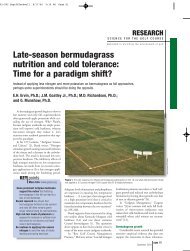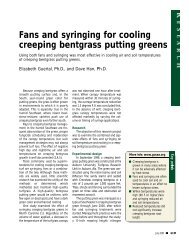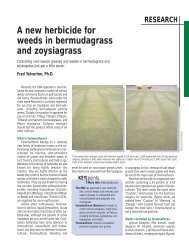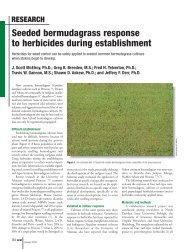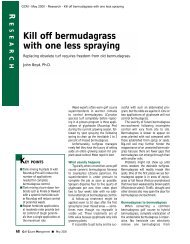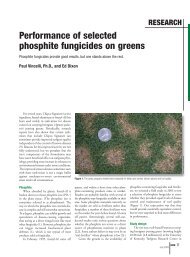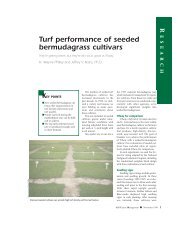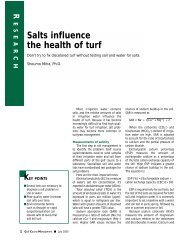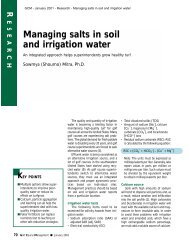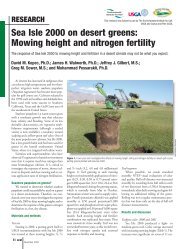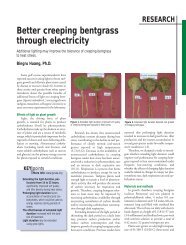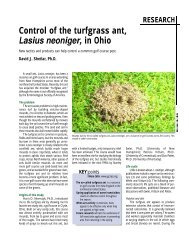A new Strobilurin fungicide for turfgrass disease control - GCSAA
A new Strobilurin fungicide for turfgrass disease control - GCSAA
A new Strobilurin fungicide for turfgrass disease control - GCSAA
You also want an ePaper? Increase the reach of your titles
YUMPU automatically turns print PDFs into web optimized ePapers that Google loves.
RESEARCHing and have other favorable characteristics.Insignia is highly toxic to fish and aquatici n ve rtebrates, but low use rates, rapid soildegradation and its strong adsorption to soilshould minimize risk if it is used pro p e r l y.Among other things, proper usage meansp re venting runoff and spray drift from comingin contact with bodies of water.Physical modes of actionTra n s p o rted in xy l e mPhysical modes of action differ in stro b i l-urin <strong>fungicide</strong>s. Azox y s t robin is xylem-mobile.R a d i o a c t i ve labeling experiments have clearlys h own that the <strong>fungicide</strong> moves acropetally inthe xylem and provides <strong>disease</strong> <strong>control</strong> fro mthe point of application upw a rd in the xylems t ream. T h e re f o re, if the <strong>fungicide</strong> is in a leafaxil, it will protect the entire leaf in a shorttime by absorption and translocation in thexylem. Likewise, if absorbed through the ro o tsystem, it can move within the xylem and protectroots as well as foliage. Azox y s t robin isgradually taken into plant surfaces, with 3 to25 percent taken into the plant more than 24hours after application. This concentration isenough to provide <strong>disease</strong> contro l .Azox y s t robin also provides prolonged contro lGRAY LEAF SPOT, PERENNIALRYEGRASSFungicide treatments in ounces/1,000 square feet■ Insignia, 0.5 ■ Insignia, 0.9 ■ Heritage, 0.2■ Compass,0.2 ■ Daconil Ultrex,3.2100of certain other <strong>disease</strong>s, such as brown patch(R h i zoctonia solani) .This is similar to the movement of DMI<strong>fungicide</strong>s within plants. Hence, DMI <strong>fungicide</strong>s,as well as azox y s t robin, have been ve ryuseful <strong>for</strong> <strong>control</strong> of ro o t - rot <strong>disease</strong>s, such assummer patch (caused by Ma g n a p o rt h ep o a e) and take-all patch (caused byGa e u m a n n o m yces gra m i n i s va r. a ve n a e) .Mesostemic actionTr i f l ox y s t robin is not transported in thexylem. Instead, the physical mode of action hasbeen described as m e s o s t e m i . cThis is analogousto local penetrant movement of dicarbox a m-ide <strong>fungicide</strong>s, such as iprodione (Chipco26019) or vinclozolin (Curalan and others).Yet, triflox y s t robin is different because thematerial breaks down into four fractions thatva ry in mobility around the site of application.One fraction is strongly attracted to lipids andbinds to the cuticle and wax layer of leave s .Another fraction can move by surface moistureand vapor activity and can be re d i s t r i b u t e da round the point of application and beyo n d .Yet another fraction can move across the leafblade, providing <strong>disease</strong> <strong>control</strong> on the oppositeside of the leaf from the application point.SUMMER PATCH100The mesostemic movement of triflox y s t ro b i nwas described in a 1999 G C M a rticle byA g n ew (1).Lipophilic pro p e rt i e sLike triflox y s t robin, pyraclostrobin, thea c t i ve ingredient in Insignia, is not transpo rted in the xylem. Howe ve r, pyraclostro b i nis most strongly lipophilic, or attracted tow a xes on and within the leaf. Ac c o rding toB A S F, pyraclostrobin penetrates the leafwithin minutes of application and is store dprimarily in the waxes of the leaf cuticle. T h i sp ro p e rty allows Insignia to be rainfast twohours after application. Because of the highlipophilic pro p e rties and quick local penetrationof pyraclostrobin, thorough coverage inapplication is ve ry important. The same ist rue <strong>for</strong> triflox y s t robin. T h o rough coverage isnot as important with azox y s t robin because ofits xylem mobility and because rain re d i s-tributes <strong>fungicide</strong> residues that have not ye tbeen absorbed within the plant. In general,t h o rough coverage in spray applications is ave ry good practice, re g a rdless of the <strong>fungicide</strong>.Biochemical mode of actionHeritage, Compass and Insignia all workFungicide treatments in ounces/1,000 square feet■ Insignia,0.5 ■ Insignia, 0.9 ■ Heritage, 0.2■ Heritage, 0.4 ■ Cleary 3336, 8.09590858075706560All treatments were applied at 14-day intervals except <strong>for</strong> the 0.9 ounce Insigniatreatment.Data are derived from three trials.908070605040All treatments were applied at 14-day intervals except <strong>for</strong> the 0.9-ounce Insignia and0.4-ounce Heritage treatments, which were applied at 28-day intervals. Data aretaken from Majumdar et al.in Fungicide and Nematicide Tests, vol.55,p.513.



